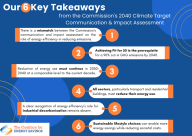Details
- Publication date
- 26 April 2024
- Author
- European Climate, Infrastructure and Environment Executive Agency
Description
This briefing reviews how energy savings and energy efficiency contribute to reaching this climate objective according to the Commission’s communication and underlying modelling.
Key findings:
- There is a clear mismatch between the Commission’s communication on the 2040 climate target and the IA regarding the role of energy efficiency and energy savings in reducing emissions. While the IA shows that reduction of energy use is a key driver to cut emissions, the communication does not sufficiently stress the contributions of energy efficiency in that respect.
- Achieving the Fit for 55 package’s objectives this decade is the prerequisite for a 90% cut in GHG emissions by 2040. This includes meeting the 2030 EU energy efficiency target and ensuring the full implementation of the 2023 Energy Efficiency Directive (EED).
- Progress in reducing energy consumption must continue in the next decade at a level of effort that is comparable to that of the 2020-2030 decade.
- All sectors must significantly reduce their energy consumption, with the largest expected drops in the transport and residential sectors.
- The importance of energy efficiency to cut emissions of Europe’s industries is mentioned, but a clear recognition of the role of energy efficiency technologies as an enabler for industrial decarbonisation is still missing.
- The adoption of more sustainable lifestyles in all sectors can enable additional energy savings while reducing the societal costs of achieving the 2040 climate goal. However, the additional energy savings that can be achieved with behavioural changes are relatively small, which may be the result of the modelling assumptions.
Download the full publication below.

Files
2040 CLIMATE TARGET: NO DECARBONISATION WITHOUT ENERGY SAVINGS
